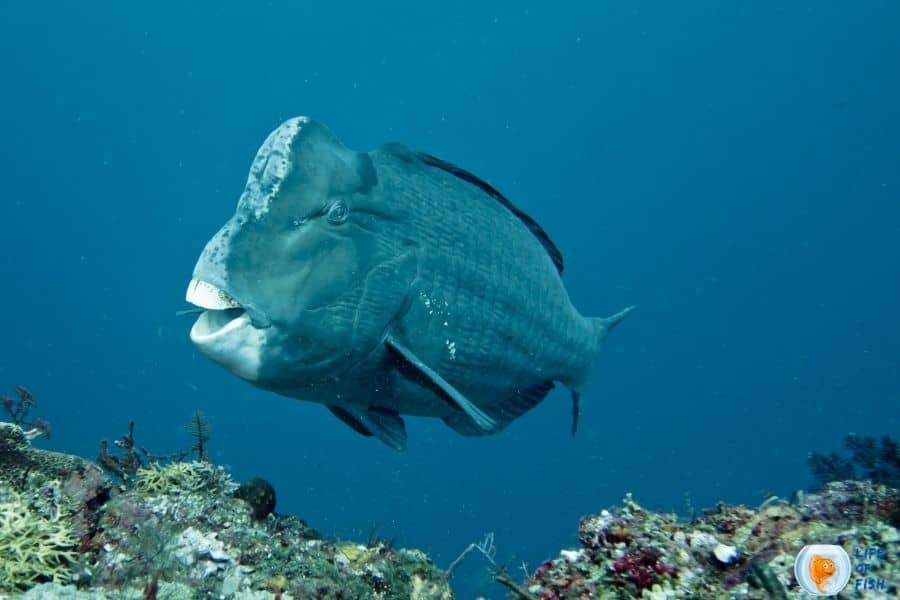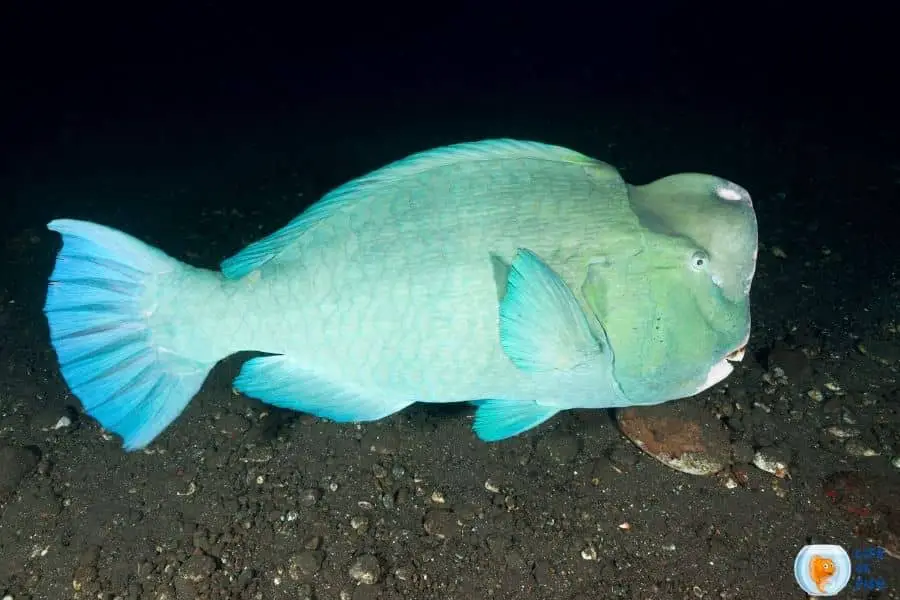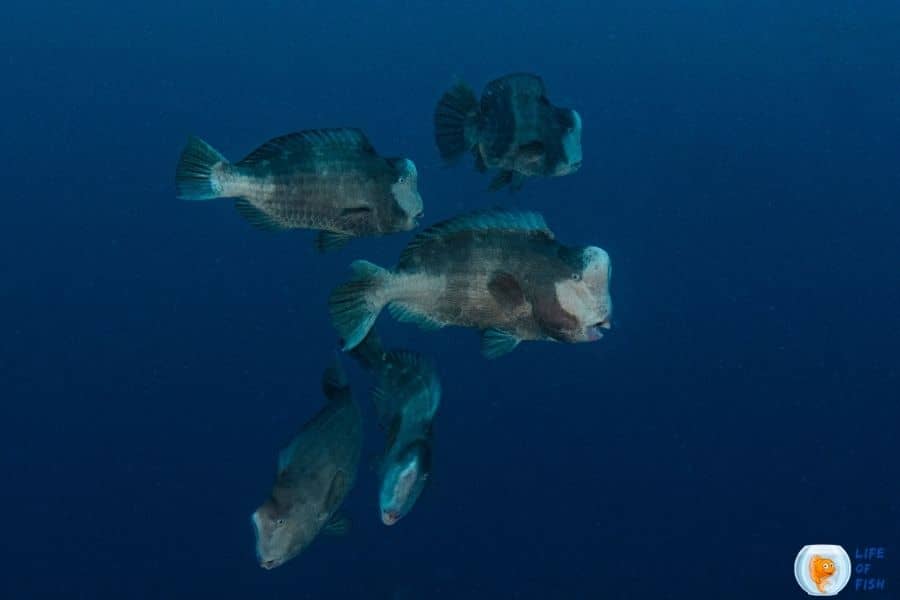The Green humphead parrotfish is the largest species of parrotfish and the largest herbivorous fish inhabiting coral reefs.
The Green humphead parrotfish is a marine-based fish. It lives near the reefs in the Indian and Pacific oceans, from the red sea in the west to Samoa in the east, and from the Yaeyama Islands in the north to the Great Barrier Reef, Australia, in the south.
It is commonly called by many names including bumphead parrotfish, humphead parrotfish, double-headed parrotfish, buffalo parrotfish, and giant parrotfish.

This species is an important reef bioeroder – sand-makers on coral reefs.
The Green humphead parrotfish belong to the order Perciformes (Perch-Like Fish), Family Scaridae (Parrotfish family ), and Genus Bolbometopon.
It is the only species in the monotypic genus Bolbometopon. The scientific name of this species is Bolbometopon muricatum.
It is recognized as vulnerable species under the IUCN red list due to overfishing habitat degradation and destruction.
How Green humphead parrotfish looks like
Jump To
- 1 How Green humphead parrotfish looks like
- 2 Where Green humphead parrotfish live
- 3 Green humphead parrotfish behavior
- 4 What does Green humphead parrotfish eat?
- 5 Green humphead parrotfish breeding
- 6 Importance of Green humphead parrotfish
- 7 Do people eat Green humphead parrotfish?
- 8 Conservation status
- 9 Related Question
- 10 Conclusion
The Green humphead parrotfish is named for its appearance, a prominent hump on the forehead, and exposed teeth that look like a beak of a parrot.
It has a vertical head profile and unlike other parrotfishes, its head is uniformly covered with scales except for the leading edge of the head.
The leading edge of their head is often light green to pink and it gives them a unique appearance.
The body of the Green humphead parrotfish is dark green as the name suggests. However, during their lifetime they change color very gradually from grayish brown to greenish-blue.
Their juveniles do not show bright colors and instead, they are dull gray with scattered white spots. When they grow up their body gradually becomes uniformly dark green.
They do not display sex-oriented patterns of color change and hence, both the female and male are the same in color.
Juveniles also do not possess a bulbous forehead and it develops when they become mature. Further, the adults of this species possess teeth plates and they are not fully covered by lips.
Parrotfish have elongated bodies with large scales. They are the largest parrotfish species both with respect to mass and length.
They can grow up to the length of 1.5 m (4.9 ft) and the weight of matured Green humphead parrotfish is 75 kg (165 lb).
The growth speed of this species is fairly low and they have a long life span, in most cases 35-40 years. Usually, it takes about three years to mature and then grow slowly.
Where Green humphead parrotfish live
The Green bumphead parrotfish are marine animals who inhabit close to coral reefs. They can be found in both the Indian Ocean and the Pacific Ocean.
They cover the areas from the red sea in the west to Samoa in the east, and from the Yaeyama Islands in the north to the Great Barrier Reef, Australia, in the south.
Their habitat varies with their growth cycle. Newly settled juveniles are found in branching coral habitats while the large juvenile green humphead parrotfish are found in lagoons, often in seagrass beds.
The adults of this species are found in clear outer lagoons and seaward reefs up to 30m.
Juveniles are found in shallower waters with seagrass beds while the adult humphead parrotfish lives in deeper waters. They love to linger around in dark sea caves or wreckage of sunk ships.
As they are tropical marine fish they prefer a temperature between 72 to 78° F and salinity between 1.020 and 1.025. Their preferred pH range lies between 8 to 12. They live between the depth range of 1 – 40 m.
Green humphead parrotfish behavior
Parrotfish are generally social and peaceful species and love to live as small groups.
These groups generally consist of 40 individuals and sometimes it may expand up to 75 individuals.
As a norm, an adult breeding male called supermale leads these groups. These supermales are typically sex-reversed females and are strongly territorial. They habitually drive other males away from their territories.
In contrast, the small juveniles of this species (<50mm) are often associated with Damselfish.
Their large hump helps to break off the pieces of coral for their digestion and sometimes they perform “head butt” with other parrotfish as a matter of competition for both food and mating.
When there is a large school of parrotfish they graze over a reef as a herd of cattle over a grassy field. They consume and excrete large amounts of calcareous materials.
Each adult fish ingests over five tons of structural reef carbonates per year and they contribute significantly to the bioerosion ( the breakdown of hard ocean substrates such as coral reefs by living organisms) of reefs.
It is said one adult humphead parrotfish can produce 2200 pounds (1 metric ton) of sand per year as it consumes and passes stony corals through its digestive tract.
They sleep among corals, in caves or shipwrecks at night, usually as large groups.
An interesting factor is that they cover themselves in a mucus cocoon to hide from their predators while they are sleeping.
This cocoon acts like a blanket and you could say they make their own blankets while sleeping !!. The mucus cocoon helps them to hide from predators both visually and by masking their scent.
However, this only works for small predators such as parasites that suck the blood of parrotfish, and large predators like sharks can still prey on them.

What does Green humphead parrotfish eat?
The Green humphead parrotfish are largely fed on algae that grows on the corals.
They can cut corals with their sharp beak-like mouth and their hump also help them to break the corals.
They use their pharyngeal teeth to grind their food;i.e. algae and coral into a paste. The fish can only digest algae and the rest of their feed; coral particles convert into tons of sand like sediment and pass out as poop.
Apart from the algae found in coral they also fed on benthic algae.
Green humphead parrotfish breeding
The most interesting factor is that most of the Green humphead parrotfish are born as females.
Further, the fish of this species who are born as males also have both female and male reproductive organs in their bodies ( hermaphroditic).
If the dominant male that leads the group dies or leaves, one of the females will go through physiological changes and become a male and take over as the dominant fish.
After the change, the male undergoes they will continue to grow to reach sexual maturity around the age of 5-7 years.
During this time females are continuing to grow to reach maturity around the age of 9-11 years. This time is different because there is a high demand for males and they grow faster than females.
After, they become mature spawning can occur throughout the year if other conditions are stable and productive.
A courting behavior can be observed in the bumphead parrotfish during the early morning of the lunar cycle.
They mate in a large tightly packed group of about 100 fish.
During their breeding cycle, males release sperm to the water and the females release eggs in shallow grooves often by aquatic plants.
These plants protect and camouflage the eggs from being eaten by predators. The eggs are fertilized with the help of moving currents and lead to the development of larvae.
The juveniles stay in shallow water /lagoons for approximately three years and then they join with the adults in deeper waters.
Importance of Green humphead parrotfish
In general, Green humphead parrotfish play a very critical role in the marine ecosystem. Parrotfish are likely the single most important species when it comes to reef health.
They eat a large volume of algae and live coral (Corals that have alga on them). This special dietary choice helps coral reefs to stay healthy and clean.
They help reefs to thrive, by eating the algae that compete with coral. However, it must be noted that they eat only the corals which have algae growth.
Therefore, eating corals is not a too much threat to the coral heath as if the algae growth became increased it affect in a bad way to the health of the coral reef as well as other marine creatures who lives near coral reefs.
As they roam around the reef as large groups they actually shape the reef while letting new corals grow. Parrotfish “discharge” up to 100 kg of white sand a year for every year of their lives.
When there is a large school of parrotfish, the excretion is higher and it gives a beautiful white sanded beach which increases the recreational value of the area. Further , the resulting sand helps to avoid beach erosion by adjeusting the sediment budget.
They are an easy target of scuba-assisted spearfishing and netting as they feed during the day and sleep at night as they always live as large groups.
Jamaeican people eat Green bumphead parrot fish and it is very popular fish in Jamica .
Do people eat Green humphead parrotfish?
Green humphead parrotfish are not considered an edible fish type in the United States. But they are extremely popular as a food in tropical islands.
The parrotfish diet of algae gives the tender white meat a very delightful, unique, and sweet shellfish flavor. They are very popular in Jamaica.

Conservation status
They are listed as Vulnerable on the IUCN ( (International Union of Conservation of Nature) Red List.
Though there are many reasons for decreasing their population, overfishing is considered the primary reason.
The Green humphead parrofish are nearly extincted in Fiji islands beacuse of Scuba-assisted spearfishing, as well as commercial fishing.
On the other hand the slow growth and low rate of reproduction make them difficult to revive their population with ease.
Though many island nations and island communities enforce laws to make sure that these fish continue to thrive in our oceans, unfortunately, it hasn’t yet been possible to go to the length of outright banning their hunting.
Related Question
What kind of fish is a Green humphead parrotfish?
The Green Humphead Parrotfish is considered a ray-finned spiny fish characterized by a sharp beak-like mouth. They are the largest fish species of parrotfish species. They are the most important species when it comes to the health of coral reefs.
Are Green humphead parrotfish rare?
Actually, they are not a rare species. They are very common around the world and are often viewed as less interesting than turtles or eagle rays.
Are Green humphead parrotfish poisonous?
Green Humphead parrotfish are not considered poisonous. But some species of the parrotfish family can be poisonous such as spotlight parrotfish.
Conclusion
Green humphead parrotfish are a unique and imperative creation of mother nature.
They are marine creatures who inhabit near coral reefs and are found in several places of the Indian and Pacific Oceans.
They play a huge role in the healthy growth of corals as well as the formation of sediments. Their main diet is algae grown in corals and they eat both coral and algae together and poop corals as sediments.
Read Next : Umbee Cichlid Care | Elegant And Fierce Fish For Your Tank | Does Molly Fish Give Birth All At Once? ( Surprising Answer ) What Do Molly Fish Eggs Look Like ? (Are They Real?)
